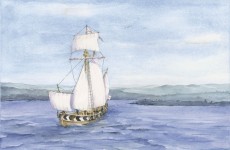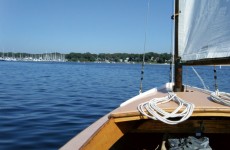For the past nine years, Points East has dedicated its July issues to families, couples and children, and their joy on the water – certainly the wellspring and essence of our little magazine’s readership. Sue Cornell, who, with her family, sails out of Brewer Pilot’s Point Marina, in Westbrook, Conn., has been a mainstay of these summer offerings.
 Her titles include “Cruising with Kids,” “Summer Programs for Sea-Kids,” “Safety for Young Salts,” “Community Boating Programs,” “Cruising Field Trips,” “Seaside Toy and Book Shops,” and “Magical History Tours.” Planning for the July 2015 issue last fall, Sue called with a very cute question, knowing full well what the answer would be: “Nim, are pets family?”
Her titles include “Cruising with Kids,” “Summer Programs for Sea-Kids,” “Safety for Young Salts,” “Community Boating Programs,” “Cruising Field Trips,” “Seaside Toy and Book Shops,” and “Magical History Tours.” Planning for the July 2015 issue last fall, Sue called with a very cute question, knowing full well what the answer would be: “Nim, are pets family?”
Well, of course they are! Thus it is that, in this year’s Family/Children Special, Sue’s 2015 feature is “Pets Aboard,” an examination of pet-friendly marinas, businesses and towns, state by state, with pithy tips from those who cruise with dogs or cats.
On the “children” side of the equation, we have often wondered at what pivotal moment a youngster falls irrevocably under the spell of boats and the sea. For author Judy Silva, it was when she was 12 and first stepped into a canoe at a Maine summer camp (see her Guest Perspective, “First Sailing Adventures,” on page 16).
For legendary English yacht designer and voyager Uffa Fox, it all began in childhood, with a desire to be, among other things, a pirate or a smuggler, which led him to the Cowes Sea Scouts, which had a sailing dinghy, a seven-ton cutter, and a rowing and sailing gig. “As the entire weekends and summer evenings were spent in these three different boats,” he wrote in “The Crest of the Wave” (1939), “I soon learned their capabilities and widely different characteristics.”
Two cruisers of centuries past credited ablutionary rituals for their lifelong worship of boats and water. English cruiser Frank G.G. Carr admitted in “A Yachtsman’s Log” (1935) that the spell was cast in the bathtub. “I fell to wondering why the model boats that sailed so well upon the nursery floor, with their varied cargoes and crews of leaden sailors, suddenly developed . . . ‘negative stability’ whenever they got into hot water.”
Nineteenth-century boating scribe Frank Cowper (aka “Jack-All-Alone”) attributed his passion for things marine to a soap dish and an iron trough beside a duck pond. After floating a soap dish in his tub, he was driven to launch the trough, board it, and head for an island in the pond.
His vessel sank while on passage. “I was actually afloat, my joy knew no bounds,” he wrote in “Jack All Alone” (1897) . . . . “So ended my first singlehanded voyage. But it was not the only boat that I have ever sunk; nor was it the end of my own struggles on the water.”
Nineteenth-century British cruising authority Claud Worth became smitten by the ships and the sea in 1876, when, as a very little boy, he stood with his uncle on Southsea Common and watched the Channel Fleet enter the narrows of Spithead under sail. This was, he wrote in “Yacht Cruising” (1910), “the most vivid of my very early recollections,” adding: “As a youngster I ran appalling risks from crazy boats and inadequate gear because no one could understand that one must sail in anything rather than not at all.”
As you read this issue, you may note that the author of The Last Word (“Connecticut Yankee on the Baltic,” page 76), Tyler Cornell, shares the surname as the writer of the lead feature. Yes, Tyler is Sue’s son, who most likely was inspired to a life at sea by magical childhood experiences on Long Island Sound with his mother, father, sister, and, of course, a succession of seagoing fur-bearers.



 We have complete issues archived to 2009. You can read them for free by following this link.
We have complete issues archived to 2009. You can read them for free by following this link.